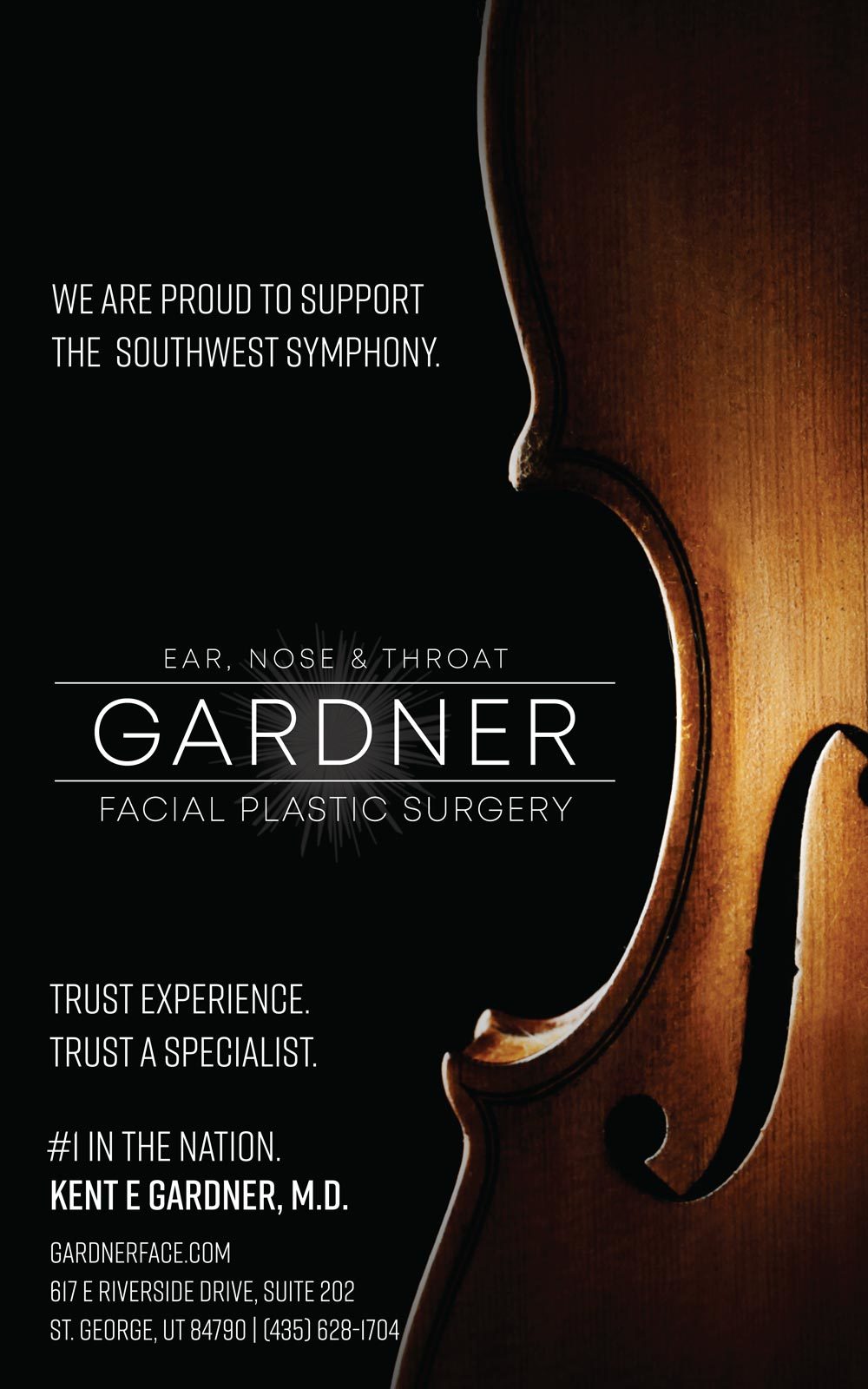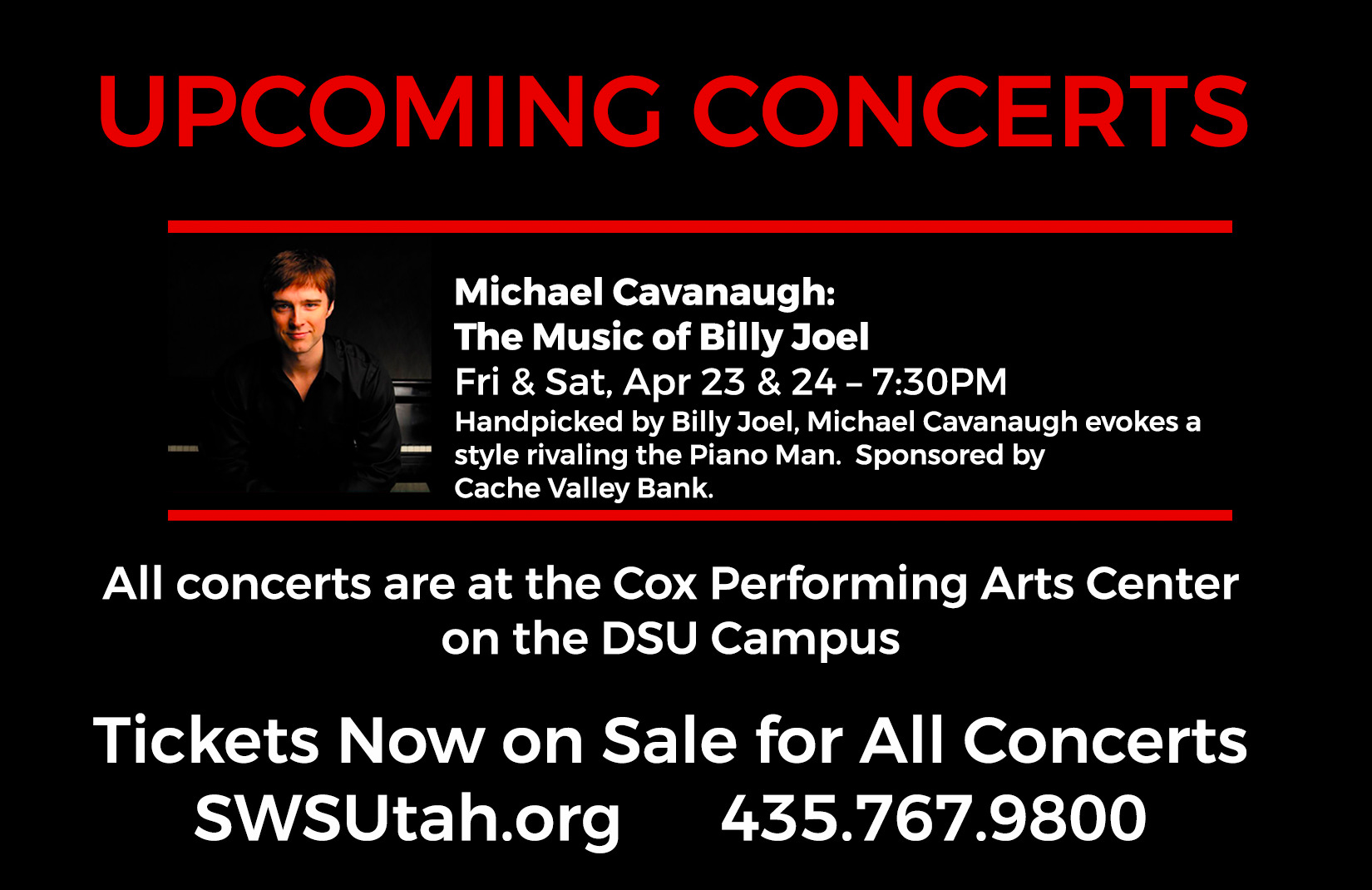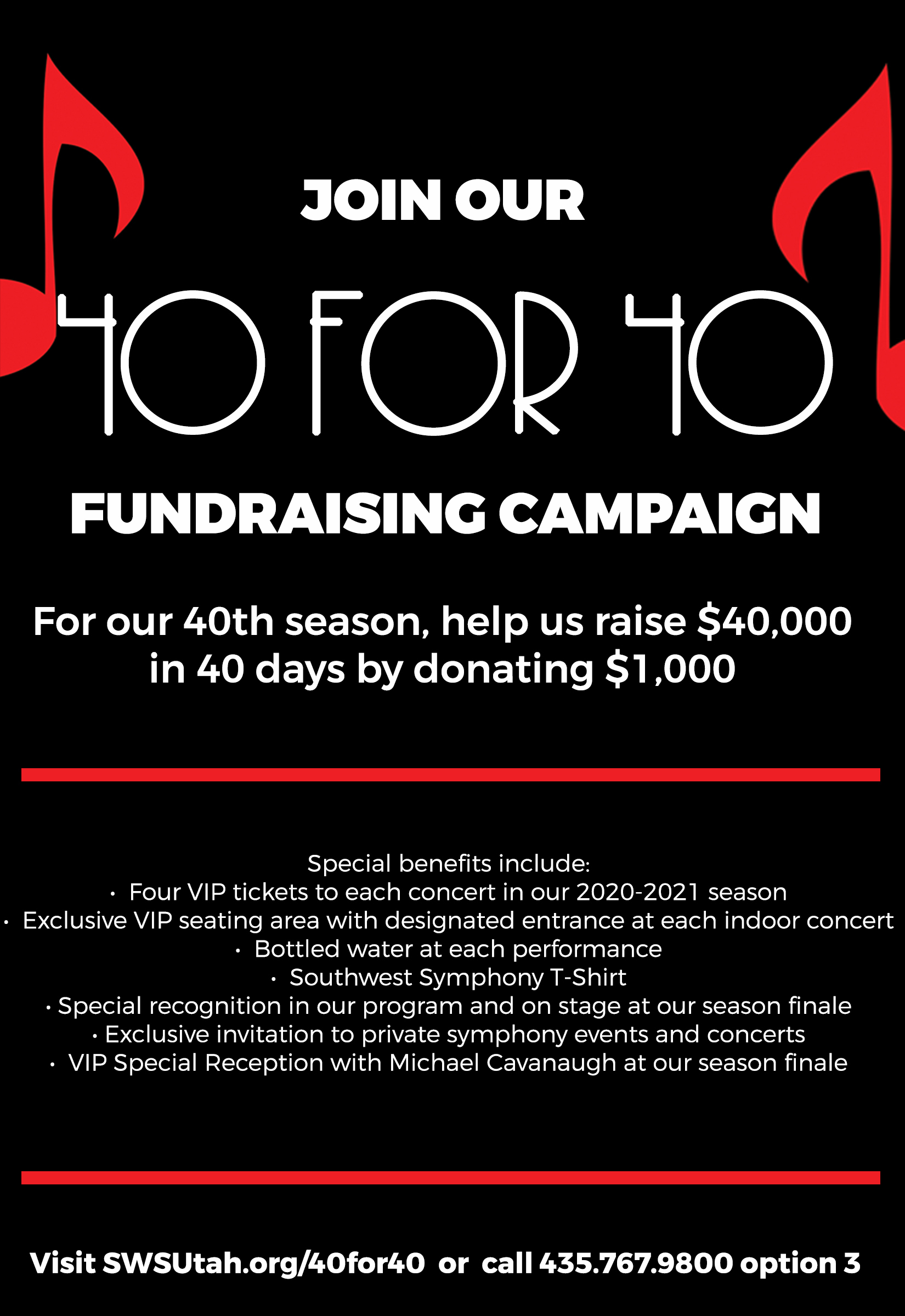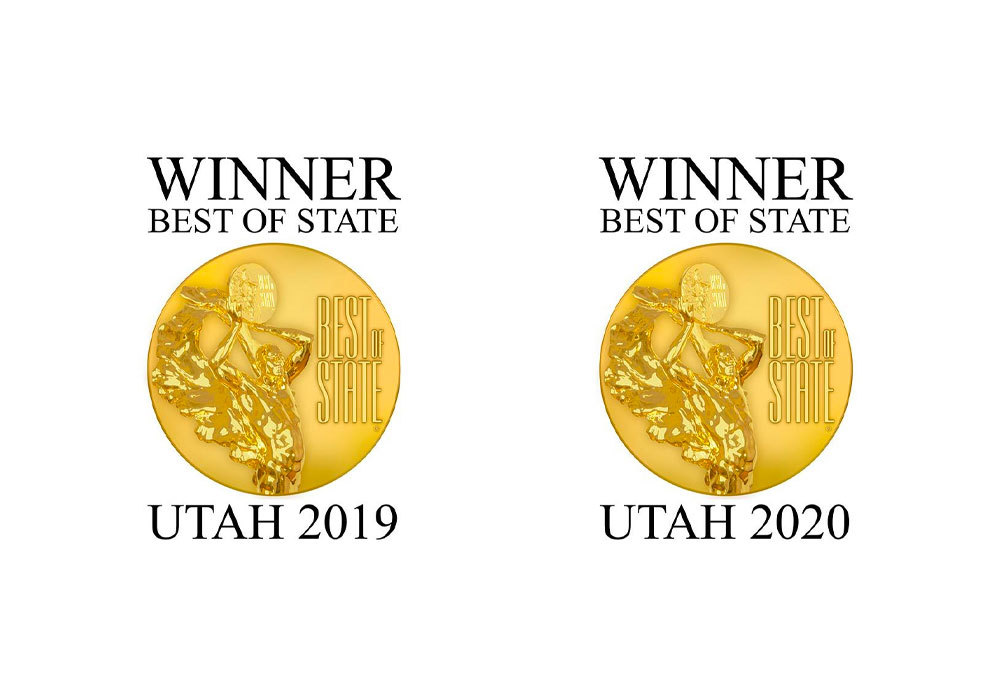Use Preferences to change the theme
Theme:
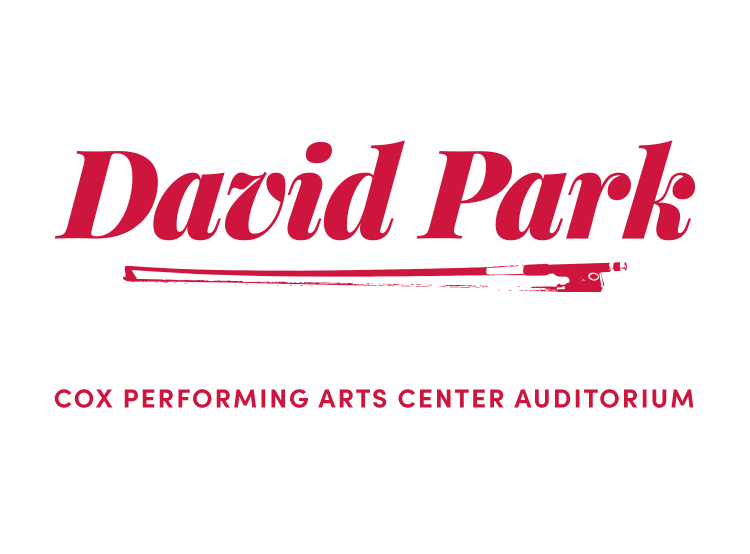
Thank you!

Follow us:
Tonight’s Program
.......
Overture to A Midsummer Night’s Dream, Op.21
Felix Mendelssohn, 1809-1847
.......
Violin Concerto in D Major, Op.35
Pytor Ilyich Tchaikovsky, 1840-1893
From the Board
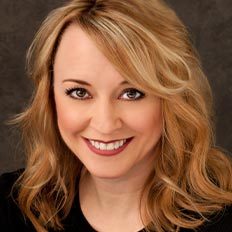
Alyce Gardner
Board Chair
Dear Friends,
Happy 40th anniversary Southwest Symphony! What an amazing 4 decades it has been filled with inspiring music. I am personally honored to have been a part of the symphony for almost 10 years both as a violinist and administrator. This legendary group of dedicated music professionals has tirelessly volunteered their time, resources and energy into keeping music alive in our community. There's no doubt - there is no substitute for live music.
We now have a unique opportunity to pledge our sustaining support. I invite you to become a friend of the symphony and give whatever you can. Your donation is critical to our future now more than ever. There are many ways to give including the 40 for 40 Campaign or through the Crescendo Club. Every dollar makes a difference. All the details can be found on our website at swsutah.org.
Please don't hesitate to reach out to me if you have questions about the symphony, you would like to become a donor, or maybe you just want to chat about your favorite composer. We are here to serve our community and we deeply appreciate your support as we continue to bring YOU music that enriches and brings joy to your life.
Here’s to another great 40 years!
Meet the Maestro
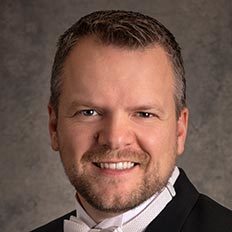
Lucas Darger
Lucas Darger returns for his fifth season with the Southwest Symphony. The Symphony has flourished under his leadership, and his innovative programming and dedication to excellence has resulted in sold-out performances becomes a regularity. Artistry has reached new heights, ticket sales have more than tripled, and the symphony has added to its educational outreach programs, giving free concerts to more than 3000 local elementary children. He has forged new ties within the community, increasing collaborations both in and out of the concert hall with local arts groups as well as other non-profits, and has established a pre-show tradition that allows students and local musicians incredible performance opportunities. He is a passionate conductor and musician and strives to achieve expressive performances that captivate and energize audiences.
Darger began his conducting career when he was just sixteen years old, and has gone on to conduct orchestras across the United States. He earned a Master’s degree in Orchestral Conducting from the University of Iowa, where he studied with the renowned Dr. William LaRue Jones, and he obtained his Bachelor’s degree in Violin Performance from the University of Utah, where he also studied conducting with Dr. Robert Baldwin. Afterwards he was accepted as a fellow at the prestigious Pierre Monteux School for Conductors in Hancock, Maine.
Proud to be a part of the St. George community, Darger serves on the board of the Music Booster Club at his children’s school, coaches football, and serves on the School Community Council. He loves the outdoors and enjoys hiking, mountain biking, skiing and boating.
Soloist Biographies
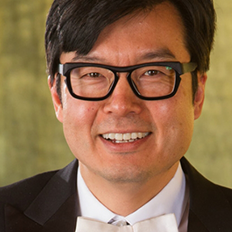
David Park
Violin
DAVID H. PARK, ‘a soloist with extraordinary artistic gifts’, (Salt Lake Tribune) started playing the violin at the age of five in Seoul, Korea. Park has studied with two of the most distinguished pedagogues, Josef Gingold and Dorothy Delay. He received his Bachelor of Music at the University of Indiana and Master of Music at the Juilliard School. At the age of 14, he was one of the last students of the legendary Jascha Heifetz.
Park maintains a balance between his engagements as soloist with orchestras throughout the world and his recital and chamber music activities. Park appeared as a soloist with the Utah Symphony, the Seoul Philharmonic Orchestra, the New York Festival Orchestra, the Korean Chamber Orchestra, Music Academy of the West Festival Orchestra, the Daegu Symphony, the Inchon Symphony and the Santa Ana Symphony. Park has given recitals in many of the world’s great concert halls including Carnegie Weill Hall and Alice Tully Hall in New York, Salle Pleyel in Paris, and Sejong Music Center in Seoul. Park has also performed on national television and radio broadcasts in the United States, France and Korea. Recently, he has been featured on CBS 2 News and FOX 13 News. Furthermore, Park has participated as both soloist and chamber musician in music festivals of Aspen, Santa Barbara, Vienna, and Aix-en-Provence.
Some of Park’s highlights include his first return to Seoul, Korea, performing the Lalo Symphonie Espagnole with the Seoul Philharmonic. Park made his New York debut performing Vivaldi’s Four Seasons in Carnegie Weill Hall. Park performed both solo and chamber music in collaboration with Augustin Dumay in France which was broadcasted nationally by France Musique, the premier classical radio station in France. In 2004, Park soloed with the Pyongyang State Orchestra of North Korea in a highly anticipated Cultural Exchange Gala Concert. Recently, he performed with Roanoke Symphony, Crown City Symphony, Pan-Asia Symphony Orchestra in Hong Kong, and Seoul Philharmonic Orchestra as a Guest Concertmaster. Furthermore, Park was invited to give a recital for Musique Au Coeur du Médoc concert series in Bordeaux, France, as well as International Music Festivals of Sulzbach-Rosenberg, Germany, Vianden, Luxembourg, and Sochi, Russia. He has presented rare series of concerts pairing Stradivari and Guarneri del Gesu violins with critical acclaim.
Park is the Assistant Concertmaster of the Utah Symphony and an Adjunct Professor of Music at the University of Utah. In 2005, Park held a position of Distinguished Artist at the University of California Santa Barbara. He has served on the jury of the Irving M. Klein International Competition in San Francisco. Prior to joining the Utah Symphony, Park was the Concertmaster of the Festival International d’Art Lyrique de Musique d’Aix-en-Provence, Wintergreen Music Festival Orchestra, the Juilliard Symphony Orchestra working with such musicians as Myung whun Chung, Leonard Slatkin, Joseph Silverstein, John Williams, Keith Lockhart, Robert Mann, and Reinhart Goeble of Antiqua Cologne.
Orchestra Members
Violin I
Rachel France, Concertmaster
Debbie Hafen, Assistant Concertmaster
Amber Morris
Julie Valadez
Lacey Young
Natalie Nelson
Cassidee Torres
Kristen Kjar
Violin II
Joie Whittaker, Principal
Lichelle Jones, Assistant Principal
Andrea Luikart
Amy Gray
Bette Adams
Melanie Nielsen
Viola
Linda Ghidossi-DeLuca, Principal
Shay Manley, Assistant Principal
Katherine Hales
Norman Fawson
Cello
Ka-Wai Yu, Principal
Peter Romney, Assistant Principal
Leslie Jack
Jessie Coombs
Mia Taylor
Ann Evans
Peggy Lambert
Joe Duwel
Bass
Denise Jones, Principal
Amy Gardner
Edwin Candland
Flute
Katrina Jones, Principal
Beth Lingwall
Oboe
Kendyl Johnson, Principal
Rhonda Rhodes
Clarinet
Melissa Bennion, Principal
Greg Johnston
Bassoon
Shanan Arslanian, Principal
Carolyn Johnston
Horn
David Lintz
David Hay
Leslie Lintz
Tabitha Nygaard
Randy Bassuener
Trumpet
LuWayne Barber
Samuel Dickson
Trombone
LuWayne Barber
Samuel Dickson
Timpani
David Salisbury
Conductor
Lucas Darger
Music Librarian
Julia Monson
Program Notes
Overture to A Midsummer Night’s Dream, Op.21
Felix Mendelssohn, 1809-1847
Felix Mendelssohn was born into a prominent Jewish family living in the northern German city of Hamburg. Tied to the North Sea by a navigable river, Hamburg was one of the important and cosmopolitan cities of Europe in Mendelssohn’s day.
Young Felix was brought up in an affluent urban family. As such, he would have taken musical training early. His mother started him on piano at age 6 and he later continued his studies under the masters of the city, where he also learned form and counterpoint. His teachers were connected to the older masters of Clementi and Bach’s musical sons. This classical upbringing would go on to influence Felix’s composition style as he matured. Mendelssohn was influenced by Bach’s use of counterpoint and we can hear echoes of the old master in Mendelssohn’s compositions. On another level, we owe the Mendelssohn-Bach connection another debt. In his later years Mendelssohn began to promote the Baroque composer’s works at his own concerts and with friends, bringing Bach’s brilliance alive once again. We owe the resurrection—or at least rediscovery—of Bach to Mendelsshon.
It was quickly recognized he was a child wonder, but unlike others of the day, the family did not promote or push Felix in the usual profit-making prodigy tours. He began to perform for the public at an early age, but it was his compositions that impressed the audiences. Between the ages of 12 and 14 he wrote twelve string symphonies, chamber works and piano works. All were well received, furthering his interest in composing for the public. During Mendelssohn’s adulthood he toured extensively, including several trips to England.
Mendelssohn’s composition style straddled the classical and romantic periods of music. While other composers were exploring new forms and tonalities, Mendelssohn's clarity of melodic development and form kept alive some of the spirit of the earlier classical traditions. Over his short life, he composed chamber works, songs, piano works, symphonies and other orchestral pieces, incidental music for plays, and major vocal works for the stage. Tonight’s selection is from the family of his orchestral works.
The Overture to A Midsummer Night’s Dream is an example of one of the first “orchestral or concert” overtures. An overture was usually the opening to an opera, in which all the major themes are introduced as a prelude, or opening, for the work. In this case, the piece was composed in the same style, but as a stand-alone concert piece inspired by the story it is based on. It could be considered a precursor of the later romantic-era tone poems, with the concert overture suggesting story and characters.
The young Mendelssohn had grown up reading a German translation of Shakespeare’s comedy/fantasy play, A Midsummer Night’s Dream. The play presented such fun character pictures, he decided to set some of the moods to music. He was 17 years old when he premiered the concert overture, and it was well received. We are listening to that overture tonight. Much later in life, the play was staged in Germany and Mendelssohn was asked to provide “incidental music” for the play. He brought back this overture and composed several other pieces to act as interlude music for this play. It is from this set of pieces that we get Mendelssohn’s famous “Wedding March”.
The overture reflects Mendelssohn’s interest in classical forms, conforming to the old sonata form, with clear transitions and regulated repetitions. The Romantic-era influences can be heard in the creative use of instrumental effects. Mendelssohn creates scampering “fairy feet” in the strings and Bottom, the donkey in the play, is mimicked by sudden perfect-fifth drops in the orchestra that sounds like the “hee-haw” you would expect from this protesting animal.
Four sustained chords in the wind section announces the beginning of our musical trip. This followed by the scurrying “fairy feet” in the high strings. This fast and delicate passage serves to unify the varying components of the overture as the fairies are always flitting about. We transition to a section that represents the “Royal Court of Athens”. This then transitions to a second theme, suggesting the lovers. One of the fun orchestral effects follows with “hee-haw of the character, Bottom. Other themes are woven in to represent the craftsmen and hunting calls. The exposition then evolves into a development section where we hear the fairies again, but with varied accompaniment and a restatement of the lovers theme in the minor key. The recapitulation portion of the sonata form starts with the opening four chords and a reiteration of the earlier themes. The fairies see us to the end, where the opening wind chords announce the dropping of the curtain on our musical play.
Violin Concerto in D Major, Op.35
Pytor Ilyich Tchaikovsky, 1840-1893
Born in Old Imperial Russia, Pytor Ilyich Tchaikovsky almost became a civil servant rather than one of the world’s most loved composers. If his dad had his way, we wouldn’t have the energy and beauty of Swan Lake, Sleeping Beauty, The Nutcracker, 1812 Overture, multiple symphonies, operas and tonight’s Violin Concerto.
In the Russia of Tchaikovsky’s day, there were no public school music programs and Tchaikovsky’s father’s job as the manager of an iron works project meant he was raised far from larger urban areas and their accompanying musical opportunities. Tchaikovsky’s mother’s background brought some musical talent and direction to her six children, and he began piano lessons at age 5. Very quickly he proved himself to be a gifted musician.
In spite of the gift, Dad thought no money could be made as a musician and sent young Peter off to the capital, St. Petersburg, to study engineering. But, when the new Saint Petersburg Conservatory opened up, Tchaikovsky applied and received one of the student positions. In a surprise occurrence, one of the world's beloved composers was set on his course. Tchaikovsky graduated from the Conservatory in 1865.
For every action there are consequences, and the new Conservatory presented a unique opportunity for Tchaikovsky. The Conservatory taught composition, harmony, and orchestration in the latest Western European idioms. This contrasted with the trends of current Russian concert music. Up to this point, Russian composers had studied privately, creating a Russian National sound. Like all national “schools”, the idea was to emphasize folk and traditional forms, idioms, and tonalities in Russian concert halls. Since Russia spread from Europe to the Pacific, representing a myriad of distinct cultures, what constituted a “Russian” sound was varied and in many ways foreign sounding to the concert audiences of Europe. The composers in the national school of Russia, who took their mission very seriously, worked to include many unusual and exotic tonalities and colors in their orchestral work. The most performed composers of this tradition are Mussorgsky, Borodin, and most importantly, Rimsky-Korsakov.
As Tchaikovsky entered the composition world in St. Petersburg, his more European approach to melody, tonality and development separated him from this Russian tradition. His relationship with the composers of the Russian and their musical aims was more off than on, but his music is still filled with Russian melodic material and treatments.
Tchaikovsky’s music, in many cases, was instantly popular, and this led him to guest instruction positions and touring. He moved throughout Europe, composing, conducting, and teaching in various cities. Two years before his death, he even made a trip to the United States, where he participated in a series of concerts to celebrate the opening of the newly constructed Carnegie Hall.
Tchaikovsky had a sensitive temperament, and took criticism to heart and could not manage long term, substantive, and meaningful personal relationships. He suffered from bouts of depression and needed “retreats” to recover. His personal life, long the subject of biographers and speculation, impacted his productivity, the nature of his work, and contributed to his rootless middle years. It was on one of these trips that he composed tonight’s composition, his only Violin Concerto.
The Violin Concerto was written over a short period in Clarens, Switzerland and was a collaborative effort with a young violinist, Josef Kotek. The two friends spent time together, playing through a great deal of music, when the idea to write his own Violin Concerto took shape. Tchaikovsky worked daily on it and Kotec would play through sections with him and offer advice on violin technique. When the work was played for Tchaikovsky’s visiting brother, everyone decided the slow movement needed work. Instead of reworking the old material, Tchaikovsky wrote a completely new slow movement. The entire work was completed in 1878
Dedicated to the great violinist, Leopold Auer, Tchaikovsky had it published and sent to him. There are multiple versions of what happened at that point, but Auer refused to perform it, and is rumored to have said that it was impossible to play.
The work was finally premiered in Vienna the winter of 1881 with Adolph Brodsky as the soloist. Many critics of the day would give negative reviews to Tchaikovsky’s new works, complaining they were too long, repetitive, and derivative. This is what happened to the premier of the violin Concerto.
Tchaikovsky may be the Stephen Spielberg of his time. Audiences loved his music, but critics downplayed his contributions as a serious composer. Tchaikovsky is the master of creating beautiful, soaring melodies...melodies that stay with us long after the concert hall. Time, which is the test of all things, proved his critics wrong.
The first movement begins with a delightful theme in the orchestral, that in a Tchaikovsky quirk, we never hear again. The soloist answers with a response that feels like improvised exploration that evolves into a new, very relaxed and singable main theme. Concertos of this period were about showing off the virtuosity of the performer, and after a fireworks section from the soloist a second theme in a new tonality is introduced. This evolves into an amazing full orchestra statement that is overwhelming in its power.
The next section leads to variations and explorations of the previous themes. This section builds to another orchestral climax, followed by an almost impossible cadenza (featuring the soloist alone without the orchestra) in the violin. The orchestra re-enters and we revisit the main theme once again. After a reprise of the second theme, the orchestra and soloist race to the end in a fast-paced finish.
The mood of the second movement is much more somber and almost retrospective at times. A series of woodwind chords is followed by the violin entering with a simple melodic statement. A contrasting theme evolves out of this development, with the main theme returning once again. With no break, we launch into the fire of the last movement.
As stated early, Tchaikovsky did use Russian themes in many of his compositions, and this last movement is a showcase of Russian flavors. The first theme is so energetic it seems the violin strings will catch fire. Too much fire burns, so there are moments of lyrical calmness, but with little warning the first theme can erupt at any time. The soloist builds more and more virtuosic complexity into the “fire” sections. Themes come in and out to provide variety, but we are just waiting to hear ever more complex fireworks from the soloist that leads to a feverishly intense finale.
– Greg Johnston


